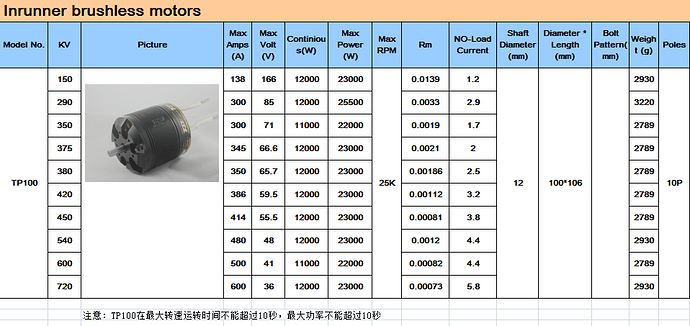There are 15:1 but not any that can handle 50k rpm, agreed. But that’s because there’s no profitable market for such a gearbox. If there were, I’m sure it can be done, probably with cooling and lubrication. My point was that its possible to produce such a gearbox, not that one is currently available.
Never said it did? In the end 50k RPM is the max rpm regardless of the KV of an 56104 motor.
It is not losing, if you never had the power. the 56104 1000KV is for ~60V and the 56104 300KV is for ~130V, sure the 1000KV version can take much more current due to thicker windings but in the end power capability keeps the same. Then it is your turn what suits you best… going higher amps or going higher voltage.
I don’t think you’re following my point. I distinctly said that the max wattage and RPM remain constant for a given motor, no matter the KV. The 56104 is a 14kw max motor, period, regardless of the winding. I mentioned this quite clearly. But yes, I’m not losing power, the power is indeed there, but I’m not utilizing the full capability of the motor by not running to nearly its max RPM. By not using the full powerband of the motor, you’re effectively losing power.
BTW, the 1000kv motor is a 50V motor, at least every link I could find:
https://www.ebay.com/itm/SSS-56104-1000KV-brushless-motor-RC-Boat-/152640203720
https://www.mhz-watercraft.com/shop/en/motors/449/sss-56104-brushless-inrunner
https://www.tfl-hobby.de/Motore–Halter–usw-/Brushless/TFL-56-mm/56104/BL-Motor-56104-1000KV—7D.html
https://picclick.com/SSS-56104-1000KV-brushless-motor-RC-Boat-152640203720.html
All of these say 50V. Where did you find it at 60V?
The point is: yeah, you could downsize the motor a lot, if there was a motor with sufficient torque at low RPM. But our problem is that the (max) power has to be at a given RPM or in other words at a given torque.
Personally I dont care if the motor is able to supply >2x max Power I need, as long as there is no other doable solution.
You can get low end torque through gearing. Imagine if I had a motor that only had 1 ft-lb of torque, but could rev to 1 million RPM. I could gear that 10000:1 and get 10000 ft-lb of torque and still have enough remaining rpm to turn wheels or props or whatever at 1000 rpm. Of course, no such magical engine exists, but it illustrates that torque and RPM can be interchanged via gearing. As i mentioned before, high RPM, low torque engines, like the formula 1 engine exists, and I guarantee that a formula 1 engine could out accelerate a 500hp engine with 2-3x the low end torque. Who do you think would win a bicycle race? A powerlifter who can squat 800 lbs but is on a single speed bike, or an average man who can only squat 200lb but has a 15 speed, geared bike? I put my money on the average man. And I bet he’s less tired too. Gears always win, which is why every real vehicle has them, cars, boats, propeller driven planes, etc.
I get, I fully understand that with our DIY e-foils we’re limited to 5:1 or 6:1, so we literally can’t use the full 50k rpm of the sss motor. But make no mistake, by doing so, even if no choice, we’re missing out on a massive amount of power. Which is why I’m going e-surf so I can gear to my heart’s content and use the full power of the motors.
 , i have been looking on that for the last 2 years…
, i have been looking on that for the last 2 years…
 Now seriously considering same motor but a twin setup. It will ease the load on the motors so then maybe torque is enough, Amp per motor will be much less, maybe can even use for each motor a cheap 150A Flysky watercooled ESC, Yamaha copy prop. Lets see!
Now seriously considering same motor but a twin setup. It will ease the load on the motors so then maybe torque is enough, Amp per motor will be much less, maybe can even use for each motor a cheap 150A Flysky watercooled ESC, Yamaha copy prop. Lets see!
